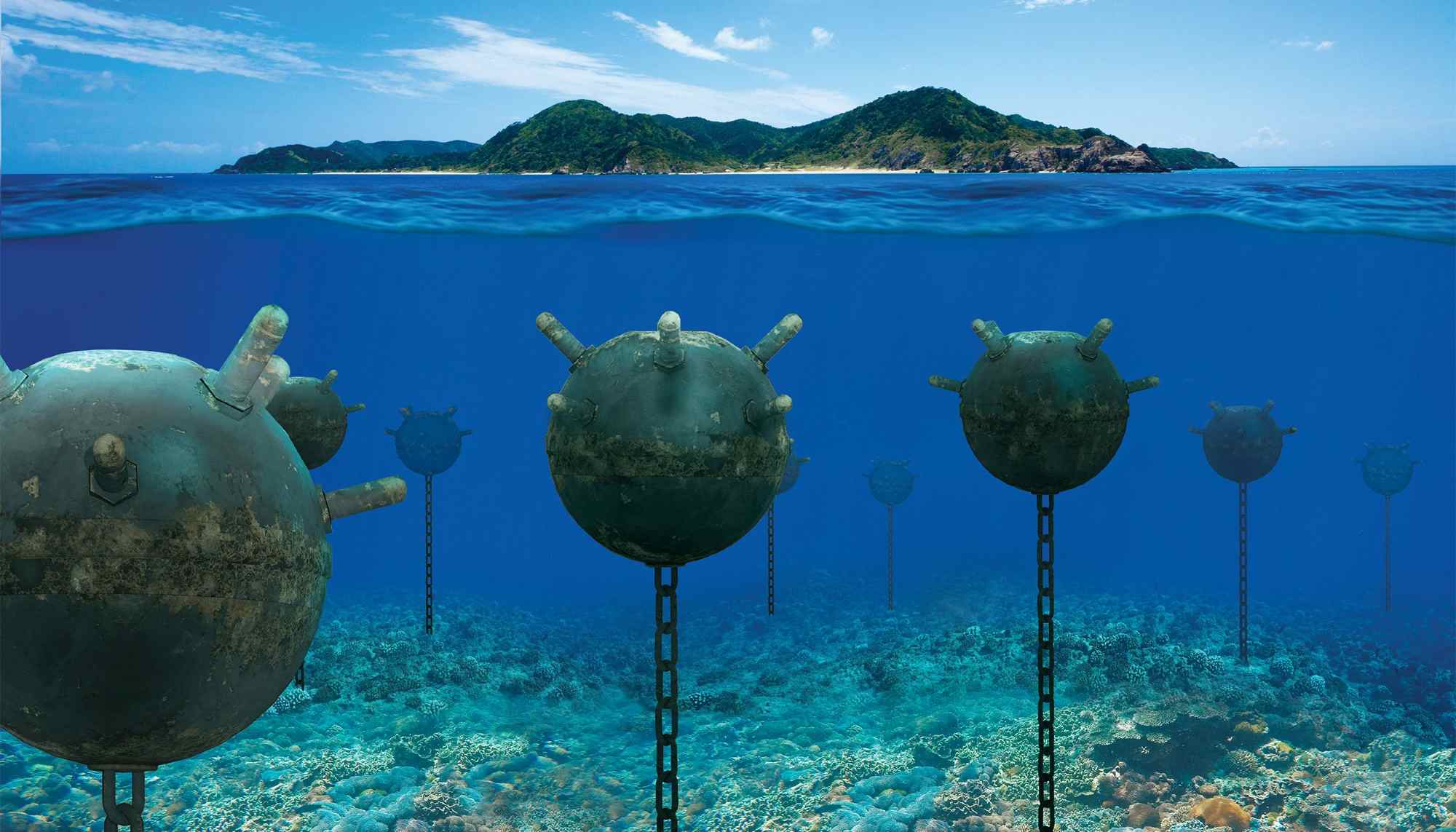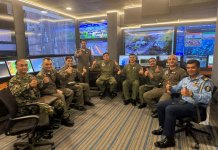Many in Taiwan and their supporters in the strategic community in the United States seem to favor applying one lesson learned from the ongoing war in Ukraine against China to thwart its aggressive designs on the island nation. That makes the Chinese invasion very difficult and expensive by mining its warships in the Taiwan Strait.
Reportedly, there have been severe Russian naval losses due to sea mines, notably in the Sea of Azov. Sea mines are said to be causing damage even to the merchant vessels in the region. International maritime trade has been impacted, with a fivefold increase in shipping rates from the area.
This lesson has led to the argument that should China decide to invade Taiwan, the landing of its forces on the island can be thwarted or delayed by successfully pre-placed mines in the Strait.
Taiwan Buying Mines From The US
Incidentally, Taiwan is purchasing Volcano mines from the United States. It is also buying M977A4 HEMTT 10-ton cargo trucks worth 180 million dollars that the mine deployment system will be mounted on. These are anti-personnel and anti-tank mines.
The Volcano mine system can deploy 960 anti-personnel/anti-tank mines in an area 1,100 meters long by 120 meters wide, and it can be deployed by truck or helicopter. The prime contractors for sale are Northrop Grumman and Oshkosh Corporation, the manufacturers of munitions and trucks.
In the Indo-Pacific region, South Korea is the other country whose forces use the Volcano mine system for their operations against potential invaders from North Korea. The US sale of Volcano is intended to strengthen Taiwan’s capacity for “asymmetric warfare” in the face of rising tensions with China, which claims Taiwan as its territory and has threatened to take the island by force if necessary.
It is said that the Volcano system would make Taiwan a tough nut to crack, slow down the enemy’s advance and buy the armed forces time to retaliate with concentrated power.
While the Volcano system would strengthen the land defense of Taiwan, similar mines can also fortify the naval defense and make Taiwan less vulnerable to attack, it is argued.
Naval mines could serve as a highly effective method of denying and confining a potential naval adversary’s precious maritime space in a theater to maneuver freely without worry of damage.
These can also tie down considerable naval forces of the adversary in a said region to painstakingly sweep its desired operational waters for mines before deploying units in the sanitized area.
A naval mine may be the cheapest and most passively deployed weapon in any navy’s arsenal. Nonetheless, it is perhaps one of the deadliest in terms of sheer firepower and outsized influence on any theater of combat it is used in.
Statistically speaking, of 18 warships lost or seriously damaged since World War II due to hostile action, 14 were struck by sea mines. And they have been proven to be cheap. For example, the two mines that damaged US warships during Desert Storm in 1991 cost $1,500 and $10,000 but collectively inflicted $21.6 million in damage.
In other words, each mine costing a few thousand dollars can inflict millions in damage on a sacrificial ship. Even if they can be eliminated by fastidious MCM (Mines Counter Measures) forces, the fact remains that MCM also costs hundreds of millions or billions of dollars for acquisition, maintenance, personnel, and training.
Coming to Taiwan, if during a conflict, the PLA Navy attempts to assess or clear minefields in the Taiwan Strait, the process could provide advance information regarding where it intends to operate. MCM efforts to evaluate and reduce risk are inherently time-consuming and resource intensive.
And since MCM platforms generally are fragile and move slowly in predictable patterns, they would prove to be easy targets of Taiwanese weapons and missiles.
As Scott Savitz of the RAND Corporation argues, Taiwan and the United States can use several well-honed tactics to elevate the risk to PLA forces. “Influence mines, which typically sit on the seafloor and detonate when they sense a ship’s signatures above them, can be designed with ‘ship counters’ that instruct them to explode when the second, third, or n-th ship passes over them.
As a result, MCM sweeping assets or low-value ships can pass through a channel and experience no damage, but subsequent, higher-value ships will. Influence mines also can be given probabilities of detonation, intermittent periods when they do not detonate, or algorithms that instruct them to detonate only in the presence of signatures for specific classes of ships.
“Collectively, these techniques to make mines a little smarter can have insidious psychological effects by creating friction among commands. Once MCM forces or low-value ships seemingly have cleared a channel, but high-value vessels are then damaged within it, a frustrated commander may become dismissive of anything that MCM forces say or do. Well-planned minefields can inspire bad choices of over-aggressive behavior or excessive timidity.
“Other mining strategies can be useful, depending on the attacker’s anticipated MCM behaviors. Attempts by the attacker to hunt the mines (i.e., to locate them using sonar) can be hindered by designing mine shapes that look like detritus or that are designed to self-bury in appropriate environments.
Putting a few moored contact mines—the classic ‘spiky balls’ that most people envision when they think of mines—into the minefield also can protract timelines since they require different MCM techniques from those used for influence mines.”
There are also improved versions of “Mobile mines” that can periodically relocate themselves, enabling a minefield to “self-heal” by creating a hazard in a previously cleared channel. For instance, during the Cold War, the United States developed the encapsulated torpedo (CapTor) mine to target submarines.
Of course, these mines are costlier, but as Savitz says, “they could be used for specialized purposes, such as securing straits through which Chinese submarines might pass en route to the open ocean.
These technologies could also be updated, given the advent of uncrewed undersea vehicles (UUVs). UUVs could potentially stretch the concept of a mine by lingering in key waterways and automatically launching torpedoes when their sensors detected approaching ships. More prosaically, UUVs also could clandestinely reseed minefields,” Savitz contends.
Taiwan Undertakes Mine Deployment Operations
Incidentally, last year, Taiwan commissioned its Navy’s First and Second Mining Operations Squadrons, which operate ships that automatically sow large numbers of small but powerful mines at high speed without divers. This was a significant development for two reasons.

One, it marked the Taiwanese Navy’s introduction to automatic mine sowing. During the commissioning, as President Tsai mentioned, the country’s previous minelayers were made from converted landing craft, were not designed for rough sea conditions, and required that sailors manually do the mine-laying.
To overcome those drawbacks, the newest minelayers manufactured by Lungteh Shipbuilding are equipped with an automatic mine-laying system designed by the National Chung-shan Institute of Science and Technology.
For another, the two newly created squadrons are the first dedicated mine-laying teams in the Taiwanese Navy’s history. Each squadron will get a single minelayer, and the mines they carry are likely to be among Taiwan’s primary lines of defense if China decides to launch an amphibious invasion.
The mines to be used by these squadrons are believed to be the improved versions of Mk 6 Mod 15 that Taiwan had acquired from the United States. It is said that there have been at least 15 variants of the Mk 6 since its introduction more than a century ago (1917), with the inert Mk 6 Mod 15 being the training mine that has been pictured aboard a minelayer during the Taiwan Navy’s mine-loading exercise last year.
The Mk 6 Mod 14 (the active variant of the Mod 15) that Taiwan may use is a surface-planted moored mine fired by the deflection of horns mounted on the case. It weighs the same as the other Mk 6 mines and is designed to be ideal for use against any ship or submarine.
Be that as it may, using sea mines by dedicated squadrons is a part of building up Taiwan’s asymmetric warfare power as per its “porcupine strategy,” a strategy first propounded by William S Murray, a professor at the United States Naval War College, in 2008. This talks of how a disadvantaged power exploits its enemy’s weakness and evades its strengths.
As Taiwanese President Tsai said, “the minelayers and their mines may be small, but they are mighty. The ships are fast, the mines are powerful, and like the country of Taiwan itself, will not be deterred by bigger, more oppressive threats.”
- Author and veteran journalist Prakash Nanda has been commenting on politics, foreign policy, on strategic affairs for nearly three decades. A former National Fellow of the Indian Council for Historical Research and recipient of the Seoul Peace Prize Scholarship, he is also a Distinguished Fellow at the Institute of Peace and Conflict Studies.
- CONTACT: prakash.nanda (at) hotmail.com
- Follow EurAsian Times on Google News




